A few weeks ago I had the opportunity to visit Boston and do a little research regarding the materials available for sewing in the colonial period. I first toured the State House where there was a display showing some of the typical products that came into the Boston Harbor from England in the 1760’s. These items include a plaid printed on linen, red silk, pottery/china, a bag of coffee, and 2 sugar cones.
One of the other displays showed this wonderful silk bodice with beautiful embroidery work. It is an incomplete piece of work and you can see the markings where the embroidery should have been if it had been finished. I would have loved to have found some embroidery threads to examine. Perhaps the threads were silk, or even cotton.
People in those days were a lot smaller than they are now! The small waist of the above embroidered piece shows how tiny the ladies were. Also, below is a man’s coat from colonial times. This appeared to be made from a velvet type material. The buttons are covered with the velvet and I was interested in looking at all of those hand worked buttonholes. What a task! The vest material looks like some sort of tapestry work. These were the types of outfits the men wore to the meetings in the Massachusetts State House where they decided the future of our country.
Also in the State House was this beautiful ladies’ fan. The white silk was painted and then incorporated into the blades of the fan. This one had obvious use but it was such a pretty piece of artwork too. I wasn’t able to discern the material used to create the blades of the fan, perhaps they were bone.
I also was intrigued by these dolls that were made completely of leather. Their faces were missing so perhaps they were made from the same products that they used to make dishes and got broken or they could have been carved from wood and rotted. During that period most dolls were “rag dolls” with cloth painted faces or dolls made from corn husks with painted faces.
These dolls were displayed in a little room at the top of the Prudential Tower. The room showed what the inside of a ship would have looked like in colonial times when immigrants arrived at Boston Harbor.
This was a container in that same room showing what the inside of a typical chest that arrived in Boston would contain. I especially loved looking closely at the linen napkins. Having done some “drawn thread” work myself, I appreciated the hours that went into the edging of these pieces of needlework.
Lastly, I enjoyed the Boston Museum of Fine Arts. There was a whole section of colonial artwork and needlework. I enjoyed looking closely at this outfit that was on display. It was a simple cotton dress with an empire waist. The shawl was beautifully embroidered at each end.
Here is a close up of the embroidery work on the shawl. The cotton dress also had white on white embroidery but it is difficult to see in these pictures. I thought the long cotton formal gloves were very elegant.
There were so many examples of colonial needlework that I couldn’t possibly photograph all of them and there was a Children’s Museum I would have liked to have visit to see the old dolls there….perhaps in another trip I can check that out. I found the city of Boston a wonderful place to visit and soak in the history of our early beginnings as a nation. If you get the chance to visit, I would highly recommend it!









